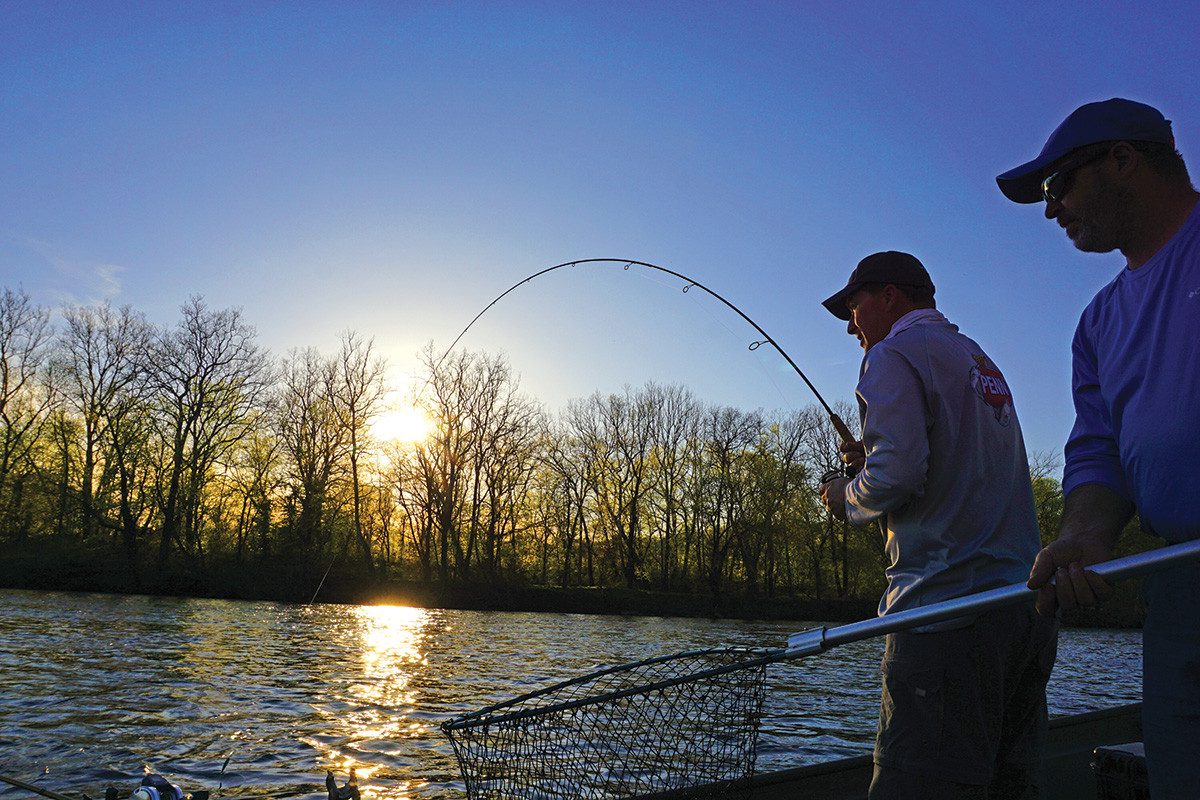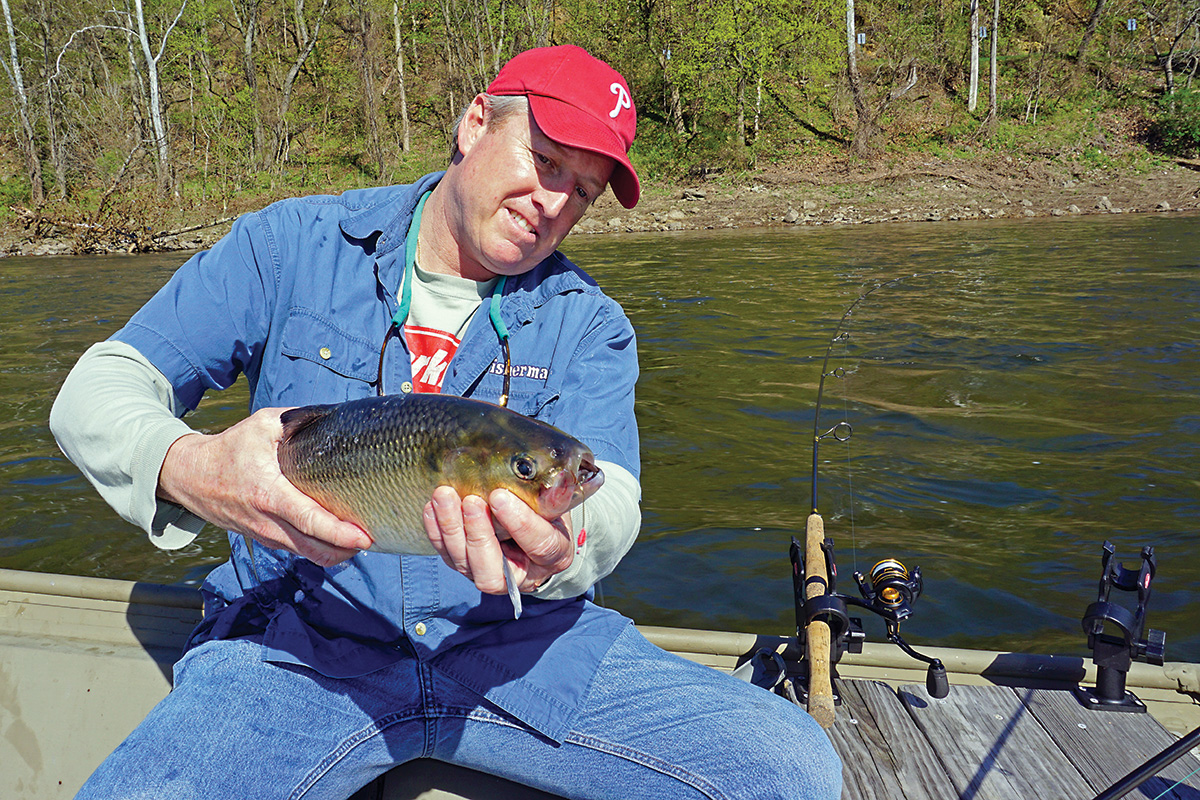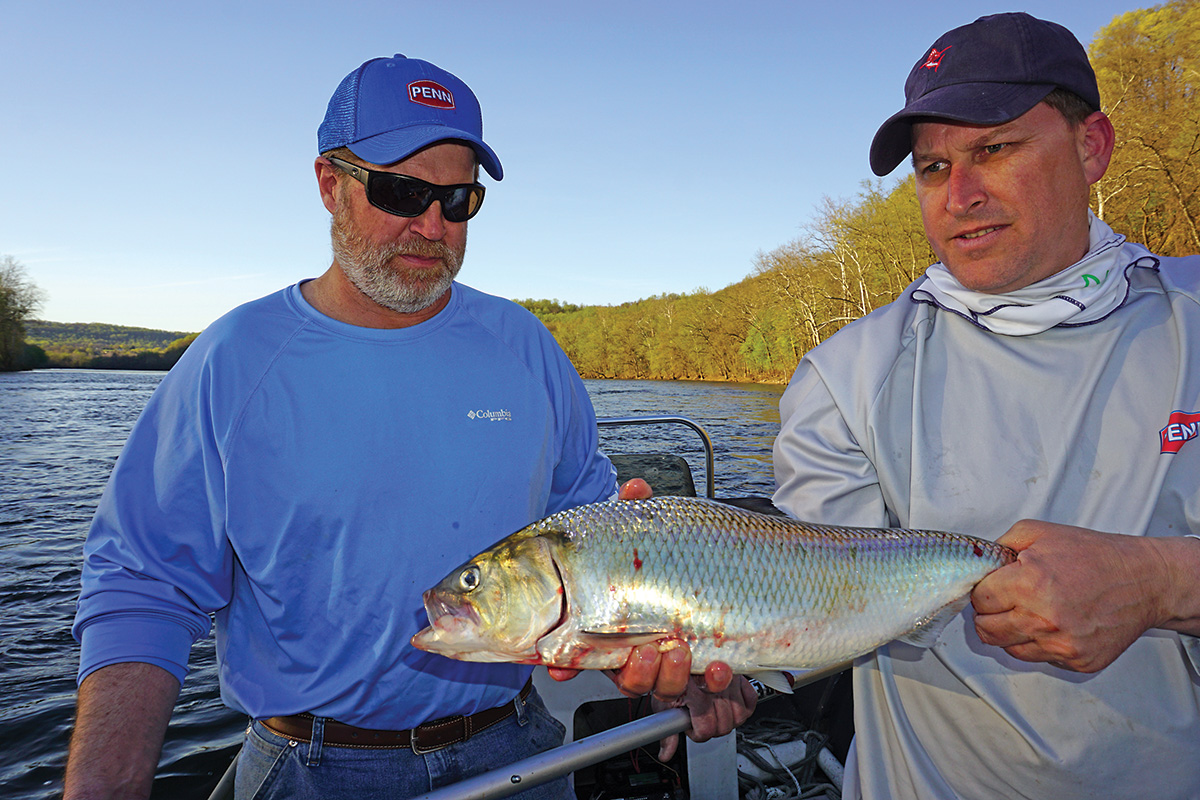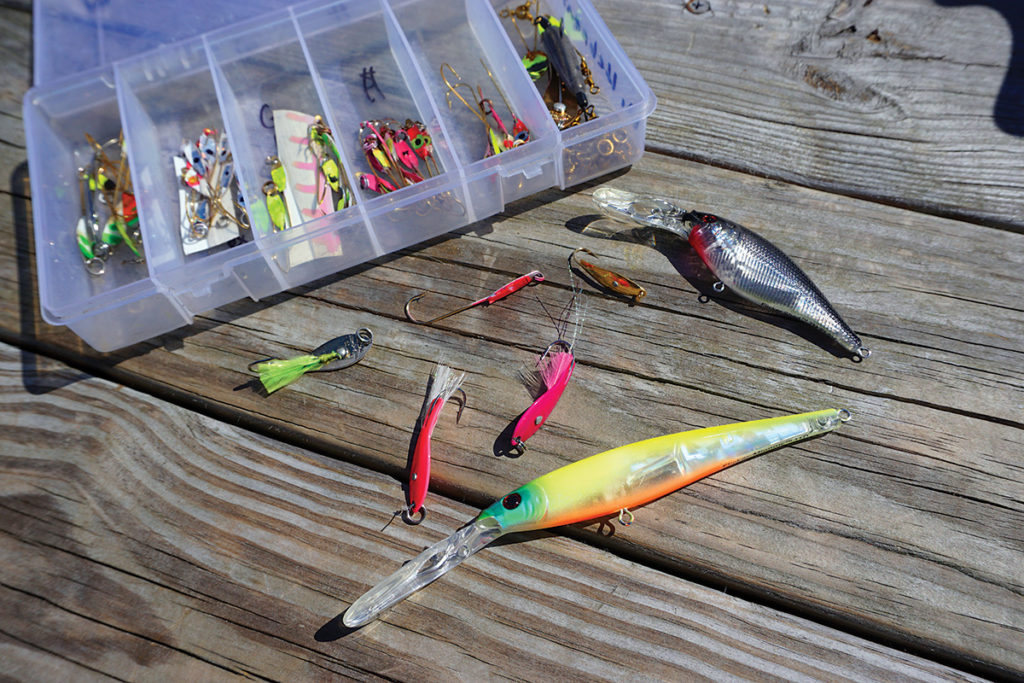Photos by Jim Hutchinson, Jr.

The fish that fed the colonists makes a revolutionary return.
During this recent winter I made my usual visits to outdoor shows and fishing shops. Everywhere I went I met plenty of anglers, and they all had the same thing on their minds, they wanted to talk about the status of American shad in the Delaware River.
I assured them the cycle of spring arriving shad had been a steady upward trend, and we are seeing huge numbers of shad arriving, the best spawn since the 1980s. Many anglers compared last spring shad arrival as good as the 1980’s peak years. We are not there yet but headed in the right direction.
During the winter, I’d predicted to friends that the shad would begin appearing sometime in late March, with the main schools arriving during April and May. Safe to say, so far so good!
The Run Is on
The Delaware River serves as the border between Pennsylvania, New Jersey and New York. It’s probably the best shad fishing river in America. It’s a relatively easy drive to reach excellent shad fishing along the Delaware, and the sport fishery continues to grow in popularity. If you are not interested in fishing for big fighting fish coming in from the Atlantic Ocean to spawn in the Delaware, you are missing out on a fabulous spring fishing opportunity. A shad hotline will give you a daily report on the Shad action (610-954-0577), courtesy of the Delaware River Shad Fisherman’s Association in Bethlehem, PA.

generating more action from shad on the move up the Delaware.
When shad leave Delaware Bay and enter the Delaware River, good fishing begins at the area of New Hope, PA/Lambertville, NJ and this is a popular place to start the season in March and April. It’s an excellent place for early season fishing, best fished via a comfortable boat. Check out where the shore anglers are casting, the find a place to begin shad fishing. Mid-April into May are good times to begin shad fishing, and they are usually active in this area of the Delaware.
Lambertville in New Jersey, just across the bridge from New Hope, PA, is the site of the Lewis Shad Fishery, who has netted shad each spring for more than a hundred years. Their daily reports are made public and serve as a good source for planning your fishing trips. Steve Meserve directs the Lewis Fishery daily netting, and said that a much needed upgrade with the nets was done during the winter and the improved netting will probably increase the nightly net count.
Boat or Shore
Each spring large schools of shad arrive from their home waters, the Bay of Fundy in Canada and enter the Delaware River to spawn. In the fall, the immense schools of juvenile shad will journey downriver, enter Delaware Bay, then will follow the Atlantic coastline northward to their home waters in the Bay of Fundy. In three years these fingerlings will return to the Delaware River as energetic fighting fish, and will average 3 to 6 pounds, and in my opinion, the best sport fighting fish on the East Coast. When you consider you could catch a dozen or more shad a day, it’s a great motivation to make plans for visiting the Delaware River this spring.
It’s an advantage to fish from a suitable boat, but you can also enjoy good fishing if you prefer to wade fish. Shad tend to follow the oxygen rich current, which creates many places where shad will be in the refreshing currents close to the shoreline, within easy casting distance of spinning or fly rod equipment. A nice benefit of shore fishing is that you fish the Pennsylvania or New Jersey shore with only one license, courtesy of a reciprocal agreement between the two states. Boats can also be launched from either shoreline with only one license.
We are blessed to have the Delaware River as a favorite target for spawning shad. The Delaware is the only river east of the Mississippi River that has remained free flowing, with no dams to impede the spring arriving shad.
300 Years Later
When early colonists arrived in the New World, the shad numbered in the millions. The Native Americans spent their spring seasons harvesting shad, with villages on both sides of the river. But as the population increased, the crystal clear waters began to lose their pristine water quality, and the shad began a slow but steady decline.
Eventually the rise of the population along the lower Delaware River, mostly in the area from Trenton to Philadelphia, led to the building of large factories that ultimately polluted the river. The World War II years were very damaging because of the local factories producing war materials, when a lot of deadly waste was dumped into the Delaware. The period from the early 1940s seriously depleted the number of shad that could manage to survive a run through the pollution. It was thought the shad were gone from the Delaware River, and shad fishermen all but disappeared.
Shad remained scarce after the war, until sometime in the mid-60s when they made an unexpected comeback. Their numbers continued to climb, and from the mid-1970s through the 1980s shad were abundant once again with hordes of anglers enjoyed great fishing. Sadly, this collapsed again in 1992 when shad were heavily targeted by offshore commercial netters. Trawlers were active through the 2003 season and took tons of shad from the Atlantic Ocean.
Thankfully, commercial shad netting was ultimately banned, and a four-year reduction of netting went into effect, with the final season being 2003. During spring of 2003, I knew the shad count would continue to be meager in the Delaware River, but felt they would rebound after the netting ban.

Seasonal Outlook
With netting pressure ended, we saw an upturn with the 2006 season, with an upward surge that continued into 2007 and 2009. By 2010 it became clear the shad population was rising, and the spawns were producing huge schools of juveniles while ensuring the return of mature, larger adults in future seasons.
Former shad anglers showed reluctance to believe the shad upturn was true, and a large number stayed away from the Delaware River fishery. The anglers who did go shad fishing were rewarded with good weather and water, and the increase in the number of shad caught was evident. In fact, after the 2017 season, I surveyed a lot of anglers and most of them encountered excellent fishing, some reporting catches of 50-plus per day. Of course some anglers reported poor results, but admitted they saw a lot of shad being caught.
The past five seasons, Mother Nature has been good to the shad and the fishermen who greet them every year. We have enjoyed good spring weather with favorable fishing conditions; of course, that weather trend didn’t get off to a great in 2018. Favorable water conditions often equate to larger numbers of juvenile shad, which means increased returns when the mature shad return for their spawning cycle.
It’s been an unusual spring that was slow to materialize weather-wise; but rest assured, the March catches were there with fishing improving slowly but surely into April. There’s plenty of time to get in on that action this month; check your rod, reel, line, shad lures, buy your fishing license, check your waders and keep the iPhone fully charged for the latest intel.
Hopefully, 2018 turns out to be another banner year!
| UP YOUR SCORE: SHAKE, RATTLE & ROLL |
|---|

When setting a successful shad spread along the Delaware River, Capt. Chris Gatley from PENN said he prefers running flutter spoons behind hookless rattling baits like the Berkley Flicker Shad (7 feet or less) or Flicker Minnow (8- to 10-foot range). “For 20 years we’ve been using non-rattling baits to dive our flutter spoons down, as opposed to using a downrigger or a dipsy diver,” Gatley said. “More recently we’ve learned that rattling baits tend to drive them nuts.” While occasionally using a dipsy diver as well, Gatley said when setting his spread at anchor, he likes to create a staggered line of baits off the transom and by using outrodders, with the rattling in particular eliciting an angry and aggressive response from shad as they move upriver along the channel edges. “I’ve learned the more rattling baits that I can get out in my spread, the more fish we’re catching, the more double-headers and triple-headers we’ve been getting,” Capt. Gatley said. |




